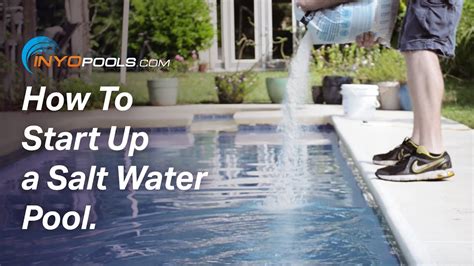How To Start Up Salt Water Pool
Ronan Farrow
Apr 02, 2025 · 3 min read

Table of Contents
How to Start Up a Saltwater Pool: A Step-by-Step Guide
Starting up your saltwater pool for the first time, or after winterization, might seem daunting, but with a methodical approach, it's a manageable process. This guide will walk you through each step, ensuring your pool is sparkling and ready for swimming in no time. Remember to always consult your pool's specific manual for detailed instructions.
Essential Pre-Startup Checklist
Before you even think about turning on the pump, you'll need to prepare your pool. This pre-startup checklist will save you time and potential headaches later:
1. Inspect and Clean:
- Thorough Cleaning: Remove any leaves, debris, or winter covers. A thorough brushing of the pool walls and floor is crucial to remove any algae or sediment build-up.
- Equipment Check: Inspect all pool equipment – pump, filter, chlorinator, lights – for any damage or wear and tear. Address any issues before proceeding. Ensure all connections are tight and secure.
- Water Level Check: Make sure the water level is at the proper level, usually a few inches below the skimmer opening.
2. Balancing Your Pool Water:
Before adding salt, your pool water needs to be balanced. This is extremely important for the health of your equipment and for the effectiveness of your saltwater chlorinator. Test the water for:
- pH: Aim for a pH level between 7.2 and 7.8. Adjust accordingly using pH increaser or decreaser.
- Alkalinity: Ideally, your total alkalinity should be between 80 and 120 ppm. Adjust with alkalinity increaser or decreaser.
- Calcium Hardness: Maintain calcium hardness between 200 and 400 ppm. Using a calcium hardness increaser if necessary.
Remember to always add chemicals slowly and carefully, following the manufacturer's instructions.
Adding Salt: The Heart of Your Saltwater System
With your water balanced, it's time to add salt. This is a crucial step, as salt is the foundation of your saltwater chlorination system.
1. Salt Measurement:
- Determine the correct amount: Refer to your saltwater chlorinator's instructions to determine the precise amount of salt needed for your pool size. This will usually be measured in pounds or kilograms per gallon or liter of water.
- Gradual Addition: Don't dump all the salt at once. Instead, add it gradually, spreading it evenly around the perimeter of the pool. This helps to prevent salt saturation in one area.
2. Dissolving the Salt:
- Circulation is Key: Run your pool pump to ensure the salt dissolves completely. This usually takes several hours, or even overnight.
- Monitoring Salt Levels: Use a reliable salt test kit to monitor the salt levels until it reaches the recommended range.
Starting the System and Initial Testing
Once the salt is dissolved, you can start up your pool system.
1. Power Up:
Turn on your pump and filter system. Allow the system to run for at least 24 hours to ensure proper circulation and salt distribution.
2. Initial Water Testing:
After 24 hours, test your water again, checking the pH, alkalinity, calcium hardness and salt level. Make any necessary adjustments.
3. Ongoing Maintenance:
Regular testing and maintenance are essential to keep your saltwater pool clean and healthy. This includes regular brushing, vacuuming, and chemical adjustments as needed.
Troubleshooting Common Issues
- Cloudy Water: This can indicate an imbalance in chemicals or insufficient filtration. Check your chemicals and ensure your filter is clean.
- High or Low Salt Levels: Adjust the salt level as needed, using a salt increaser or diluting with fresh water (if necessary). Always refer to your salt chlorinator’s instruction manual.
- Algae Growth: Proper chemical balance and regular brushing are key to preventing algae. If algae appear, treat it promptly using an algaecide.
By following these steps, you can successfully start up your saltwater pool and enjoy a refreshing, clean swimming experience all season long! Remember that consistency in testing and maintenance is key to a healthy and enjoyable pool.
Featured Posts
Also read the following articles
| Article Title | Date |
|---|---|
| How To Take Avexia Tablets | Apr 02, 2025 |
| How To Pull A Tube Without A Tow Bar | Apr 02, 2025 |
| How To Trap Raccoons In A Live Trap | Apr 02, 2025 |
| How To Sue A Bar For Negligence | Apr 02, 2025 |
| How To Start A Gun Store | Apr 02, 2025 |
Latest Posts
-
How Big Is St Lucia Compared To A Us State
Apr 03, 2025
-
How Big Is Rt 44 At Sonic
Apr 03, 2025
-
How Big Is North Korea Compared To Texas
Apr 03, 2025
-
How Big Is Nine Inch
Apr 03, 2025
-
How Big Is Lost Lands
Apr 03, 2025
Thank you for visiting our website which covers about How To Start Up Salt Water Pool . We hope the information provided has been useful to you. Feel free to contact us if you have any questions or need further assistance. See you next time and don't miss to bookmark.
